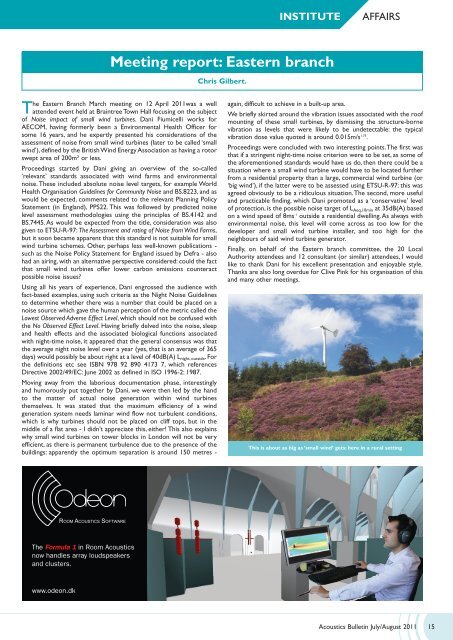Acoustics Bulletin Jul-Aug 2011 - Institute of Acoustics
Acoustics Bulletin Jul-Aug 2011 - Institute of Acoustics
Acoustics Bulletin Jul-Aug 2011 - Institute of Acoustics
You also want an ePaper? Increase the reach of your titles
YUMPU automatically turns print PDFs into web optimized ePapers that Google loves.
INSTITUTE<br />
AFFAIRS<br />
Meeting report: Eastern branch<br />
Chris Gilbert.<br />
The Eastern Branch March meeting on 12 April <strong>2011</strong>was a well<br />
attended event held at Braintree Town Hall focusing on the subject<br />
<strong>of</strong> Noise impact <strong>of</strong> small wind turbines. Dani Fiumicelli works for<br />
AECOM, having formerly been a Environmental Health Officer for<br />
some 16 years, and he expertly presented his considerations <strong>of</strong> the<br />
assessment <strong>of</strong> noise from small wind turbines (later to be called ‘small<br />
wind’), defined by the British Wind Energy Association as having a rotor<br />
swept area <strong>of</strong> 200m² or less.<br />
Proceedings started by Dani giving an overview <strong>of</strong> the so-called<br />
‘relevant’ standards associated with wind farms and environmental<br />
noise. These included absolute noise level targets, for example World<br />
Health Organisation Guidelines for Community Noise and BS.8223, and as<br />
would be expected, comments related to the relevant Planning Policy<br />
Statement (in England), PPS22. This was followed by predicted noise<br />
level assessment methodologies using the principles <strong>of</strong> BS.4142 and<br />
BS.7445. As would be expected from the title, consideration was also<br />
given to ETSU-R-97: The Assessment and rating <strong>of</strong> Noise from Wind Farms,<br />
but it soon became apparent that this standard is not suitable for small<br />
wind turbine schemes. Other, perhaps less well-known publications -<br />
such as the Noise Policy Statement for England issued by Defra - also<br />
had an airing, with an alternative perspective considered: could the fact<br />
that small wind turbines <strong>of</strong>fer lower carbon emissions counteract<br />
possible noise issues<br />
Using all his years <strong>of</strong> experience, Dani engrossed the audience with<br />
fact-based examples, using such criteria as the Night Noise Guidelines<br />
to determine whether there was a number that could be placed on a<br />
noise source which gave the human perception <strong>of</strong> the metric called the<br />
Lowest Observed Adverse Effect Level, which should not be confused with<br />
the No Observed Effect Level. Having briefly delved into the noise, sleep<br />
and health effects and the associated biological functions associated<br />
with night-time noise, it appeared that the general consensus was that<br />
the average night noise level over a year (yes, that is an average <strong>of</strong> 365<br />
days) would possibly be about right at a level <strong>of</strong> 40dB(A) L night, outside . For<br />
the definitions etc see ISBN 978 92 890 4173 7, which references<br />
Directive 2002/49/EC: June 2002 as defined in ISO 1996-2: 1987.<br />
Moving away from the laborious documentation phase, interestingly<br />
and humorously put together by Dani, we were then led by the hand<br />
to the matter <strong>of</strong> actual noise generation within wind turbines<br />
themselves. It was stated that the maximum efficiency <strong>of</strong> a wind<br />
generation system needs laminar wind flow not turbulent conditions,<br />
which is why turbines should not be placed on cliff tops, but in the<br />
middle <strong>of</strong> a flat area - I didn’t appreciate this, either! This also explains<br />
why small wind turbines on tower blocks in London will not be very<br />
efficient, as there is permanent turbulence due to the presence <strong>of</strong> the<br />
buildings: apparently the optimum separation is around 150 metres -<br />
again, difficult to achieve in a built-up area.<br />
We briefly skirted around the vibration issues associated with the ro<strong>of</strong><br />
mounting <strong>of</strong> these small turbines, by dismissing the structure-borne<br />
vibration as levels that were likely to be undetectable: the typical<br />
vibration dose value quoted is around 0.015m/s 1.75 .<br />
Proceedings were concluded with two interesting points. The first was<br />
that if a stringent night-time noise criterion were to be set, as some <strong>of</strong><br />
the aforementioned standards would have us do, then there could be a<br />
situation where a small wind turbine would have to be located further<br />
from a residential property than a large, commercial wind turbine (or<br />
‘big wind’), if the latter were to be assessed using ETSU-R-97: this was<br />
agreed obviously to be a ridiculous situation. The second, more useful<br />
and practicable finding, which Dani promoted as a ‘conservative’ level<br />
<strong>of</strong> protection, is the possible noise target <strong>of</strong> L Aeq,10min at 35dB(A) based<br />
on a wind speed <strong>of</strong> 8ms -1 outside a residential dwelling. As always with<br />
environmental noise, this level will come across as too low for the<br />
developer and small wind turbine installer, and too high for the<br />
neighbours <strong>of</strong> said wind turbine generator.<br />
Finally, on behalf <strong>of</strong> the Eastern branch committee, the 20 Local<br />
Authority attendees and 12 consultant (or similar) attendees, I would<br />
like to thank Dani for his excellent presentation and enjoyable style.<br />
Thanks are also long overdue for Clive Pink for his organisation <strong>of</strong> this<br />
and many other meetings.<br />
This is about as big as ‘small wind’ gets: here in a rural setting<br />
The Formula 1 in Room <strong>Acoustics</strong><br />
now handles array loudspeakers<br />
and clusters.<br />
www.odeon.dk<br />
<strong>Acoustics</strong> <strong>Bulletin</strong> <strong>Jul</strong>y/<strong>Aug</strong>ust <strong>2011</strong> 15

















